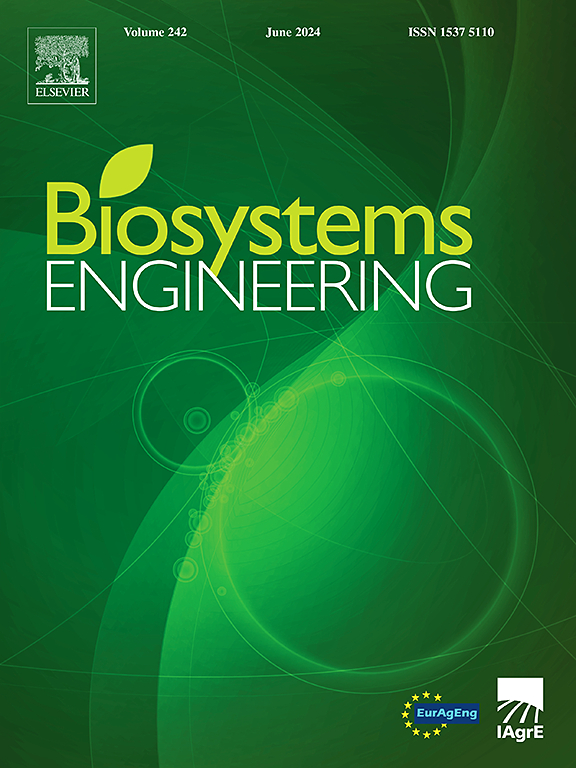The cubicle hood sampler: Design of a practical system for the measurement of dairy cows’ methane production rates
IF 4.4
1区 农林科学
Q1 AGRICULTURAL ENGINEERING
引用次数: 0
Abstract
Monitoring methane production from individual cows is crucial for the implementation of greenhouse gas reduction strategies. However, monitoring methane production rates (MPR) under practical conditions and with acceptable levels of accuracy, intrusiveness, and throughput remains challenging. In this study, we present a renewed design of the Cubicle Hood Sampler (CHS) as a potential solution to this challenge.
Placed in the cubicles, the CHS collects and analyses the methane content of the air exhaled by cows when lying down. The ability of four CHS units to recover known MPR was assessed in three series of recovery tests using a reference method (artificial reference cow (ARC)). For the fluxes tested, there were no significant difference in recovery rates (mean 110.5 ± 8.7%) between CHS units (p = 0.207), production rates (p = 0.080), and repetitions (p = 0.148). Recovery rates appeared not to be significantly different from 100% (p = 0.154), and root mean square error equated 35.0g, which is considered acceptable for MPR levels of 200 and 400g/day. Repeatability equated 0.94, showing the high repeatability and reliability across replicates. These results place the CHS as a promising tool for on-barn methane measurements. However, the radio frequency identification used to link measurements to specific cows did not yield sufficient levels of correct identification. Similarly, the monitoring of head poses was not satisfactory, and the CHS still requires further improvements to be made.
隔间罩取样器:一种实用的奶牛甲烷产率测量系统的设计
监测单个奶牛的甲烷产量对于实施温室气体减排战略至关重要。然而,在实际条件下,以可接受的精度、侵入性和产量水平监测甲烷产量(MPR)仍然具有挑战性。在这项研究中,我们提出了一种新的隔间罩采样器(CHS)设计,作为解决这一挑战的潜在方案。放在小隔间里,CHS收集并分析奶牛躺下时呼出的空气中的甲烷含量。采用一种参考方法(人工对照牛(ARC)),通过三个系列的恢复试验评估了四个CHS单位恢复已知MPR的能力。对于所测试的通量,CHS单元之间的回收率(平均110.5±8.7%)(p = 0.207)、产率(p = 0.080)和重复次数(p = 0.148)无显著差异。回收率似乎与100%没有显著差异(p = 0.154),均方根误差为35.0g,这被认为是可以接受的MPR水平为200和400g/天。重复性为0.94,表明该方法具有较高的重复性和可靠性。这些结果使CHS成为一种很有前途的工具,用于谷仓甲烷测量。然而,用于将测量结果与特定奶牛联系起来的射频识别并没有产生足够的正确识别水平。同样,对头部姿势的监测也不令人满意,CHS还需要进一步改进。
本文章由计算机程序翻译,如有差异,请以英文原文为准。
求助全文
约1分钟内获得全文
求助全文
来源期刊

Biosystems Engineering
农林科学-农业工程
CiteScore
10.60
自引率
7.80%
发文量
239
审稿时长
53 days
期刊介绍:
Biosystems Engineering publishes research in engineering and the physical sciences that represent advances in understanding or modelling of the performance of biological systems for sustainable developments in land use and the environment, agriculture and amenity, bioproduction processes and the food chain. The subject matter of the journal reflects the wide range and interdisciplinary nature of research in engineering for biological systems.
 求助内容:
求助内容: 应助结果提醒方式:
应助结果提醒方式:


